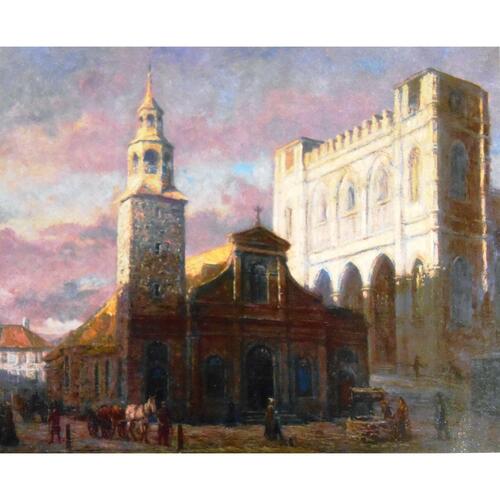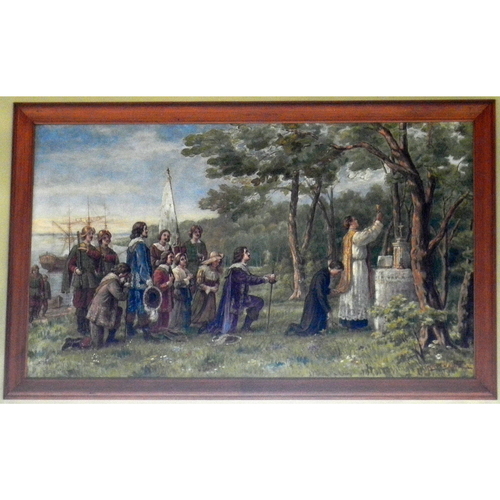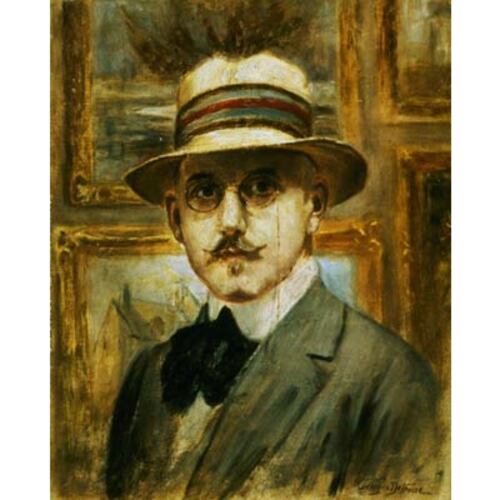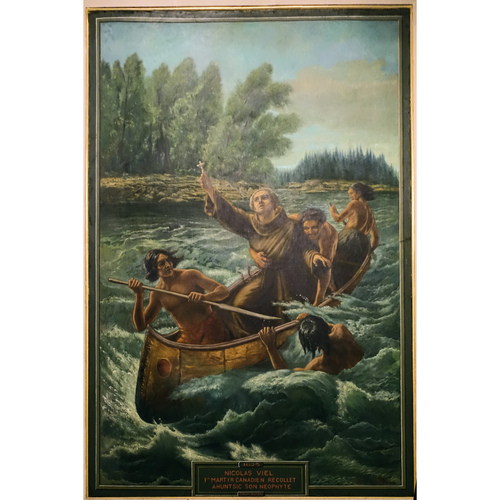
Source: Link
DELFOSSE, GEORGES (baptized Marie-Joseph-Georges Delfausse), painter, illustrator, and teacher; b. 8 Dec. 1869 in Saint-Henri-de-Mascouche (Mascouche), Que., son of Melaine Delfausse, a seigneurial agent and postmaster, and Josephine Mount; m. 14 May 1908 Aline Contant, daughter of Alexis Contant*, in Montreal, and they had three daughters and one son; d. there 22 Dec. 1939.
In 1882 the family of Georges Delfosse left Saint-Henri-de-Mascouche to settle in Montreal, where he studied at the École Saint-Jacques and the Collège de Saint-Laurent. Recognizing the young man’s obvious artistic talent, his uncle Philippe Edmond Mount, a physician, enrolled him in drawing classes taught by Abbé Joseph Chabert* at the National Institute of Fine Arts, Sciences, Arts, Trades, and Industries. In April 1885 the work Delfosse displayed at the institute’s exhibition attracted attention. His first order book shows that he began to secure contracts in June of that year. He continued his studies at the Council of Arts and Manufactures of the Province of Quebec, where he took lessons from Louis-Philippe Hébert* and Edmond Dyonnet, and at the Art Association of Montreal, headed by the artist William Brymner*, who also taught him.
On 27 Sept. 1890 Le Monde illustré reported that Delfosse was showing his work at the Exposition des Beaux-Arts in Montreal. The young artist was described as a painter of promising talent who “will certainly succeed in making his name known.” For Delfosse the year 1890 marked the beginning of a fruitful engagement in religious painting with the execution of a canvas for the church of Saint-Henri-de-Mascouche. Throughout his career, he would produce paintings for many churches, mainly in the province of Quebec (including three for the church of Saint-Louis-de-France in Montreal, which was destroyed by fire in January 1933), but also in Ontario and the United States. In 1891 three of his paintings, including a likeness of his uncle Philippe, won awards at the provincial exhibition in Montreal. In June 1896 his portrait of Wilfrid Laurier* – who became prime minister of Canada on the 23rd of that month – established his talent for this pictorial genre. According to a note Delfosse made in his first order book, more than 50,000 people came to see the work as it hung in the offices of the newspaper Le Soir from 17 June to 2 July. It would then be displayed at the Society of Arts of Canada in Montreal until December.
In 1900 Delfosse founded the Société Canadienne de Portraits et de Tableaux à l’Huile; at the studio he named Art National, he offered his services as a portraitist to the public with flexible terms of payment. His first order book, which terminates in 1905, attests to the popularity of this enterprise from the beginning of the 20th century. Of note among his depictions of famous subjects are those of Edward VII, Sir Lomer Gouin*, and Sir Alexandre Lacoste*, executed in 1902, 1923, and 1928–31 respectively. The artist also turned his hand to illustration. His drawings appeared in Femmes rêvées by Albert Ferland* in 1899, in Florence by Rodolphe Girard the following year, and in the second edition of Contes vrais by Pamphile Le May* in 1907.
On 15 May 1908 Delfosse and Aline Contant, who were newly married, left for Europe on their honeymoon. This journey gave Delfosse the opportunity to hone his skills in Paris while frequenting the studio of master painter Léon Bonnat and taking lessons from Russian artist Alexei Harlamoff. He worked on the seven historical scenes that would decorate the side aisles of Montreal’s cathedral. After a seven-month stay, the couple, who had been living on Rue de Beaune in the City of Light, returned to Montreal.
In 1910 Delfosse did the commemorative painting of the International Eucharistic Congress held in Montreal. His canvas, La bénédiction de Montréal, was reproduced as an engraving by La Patrie and distributed to the newspaper’s subscribers. By this time Delfosse had earned a solid reputation and had a large following. Many students came to his studio for his drawing classes and lessons on motif. The artist also taught drawing to his young cousin Rita Mount, who in 1920 would paint pictures for the churches of Sainte-Madeleine (in Rigaud) and St Francis Xavier (in Renfrew, Ont.) for him. In addition, he initiated into the arts of drawing and painting both his daughter Madeleine, who would become a painter, and his wife. Between 1911 and 1917 the students who came to his studio included the young artist Rodolphe Duguay*. In exchange for lessons, Duguay applied broad brush strokes to his master’s paintings, carved frames, and accompanied him in his work on the many projects that he executed in churches, in particular those carried out under the direction of decorator and painter Toussaint-Xénophon Renaud. Delfosse’s students also included painters Narcisse Poirier, Émile Vézina, and Olivier Beaulieu as well as architect Ludger Venne, all of whom would distinguish themselves by their art.
In May 1914 Delfosse again travelled to Europe. Accompanied by his wife and children, he went to Paris, where he painted six of the pictures for Très-Saint-Nom-de-Jésus church in Montreal. The Delfosse family lived on Quai de la Tournelle at the corner of Rue de Pontoise, and the painter had the use of a studio on Rue Visconti. Forced to return to Canada in August with the outbreak of World War I, Delfosse suffered a misadventure in Le Havre, which he described in his notes on the trip. He was discovered making a sketch of the Chicago, the ship that was to take him and his family back to America. Arrested on suspicion of espionage, he was soon released so he would not miss the vessel’s departure. On 23 August the Delfosse family disembarked in New York, and from there they made their way back to Montreal.
In March and April 1917 Delfosse held an exhibition at the Bibliothèque Saint-Sulpice in Montreal on the theme of Old Montreal, a subject that would be a distinguishing feature of his career and of the body of his work. Among the 55 canvases displayed were La maison de Gédéon de Catalogne [Gédéon (de) Catalogne*], La vieille église Notre-Dame, and La rue Saint-Amable. Delfosse, who was later nicknamed the painter of Old Montreal, attached less importance to the aesthetic quality of a place than to its history. With the help of advice from archivist Édouard-Zotique Massicotte*, he applied himself to the depiction of ancient, little-known, or lost sites.
For more than 30 years Delfosse lived on Rue Sherbrooke. In 1924 he had his former student Venne build him a house with a studio, where he would stay for about a dozen years. In this residence, which showed the signs of a certain affluence, he occasionally held shows of his works (notably, one in October 1925). In 1932 he was apparently the victim of a serious automobile accident from which he would never recover. His last commission is dated March 1933.
Delfosse’s output, consisting of more than 3,000 works, is diverse. It includes paintings, frescoes, murals, pastels, watercolours, engravings, drawings, portraits, large religious compositions, and rural and urban landscapes. It testifies to the special ability the artist had developed for bringing light into play. Thus, to quote Denise Brosseau, “he would move from rather cold colours to warm, highly luminous hues. The sombre tones borrowed from his religious paintings would often be pierced by moonlight, a subtle glimmering at the window.” Delfosse’s artistic legacy is therefore significant. In the 1980s two important exhibitions would pay homage to his work. The first, on the theme of Old Montreal, took place in the metropolis in July and August 1983. A retrospective of his work was held in Mascouche from 27 to 29 Oct. 1989. Several museums and galleries (such as the McCord Museum of Canadian History in Montreal and the National Gallery of Canada in Ottawa) and various other bodies (the City of Montreal and the Power Corporation of Canada, for example) own some of Delfosse’s canvases. The majority of his works, however, are to be found in the Musée National des Beaux-Arts du Québec, which also has an archival collection devoted to him. Two streets in the province are named in his honour: one in Terrebonne (1997) and the other in the Saint-Laurent district of Montreal (2010).
Described by Bishop Olivier Maurault* as a “mercenary artist” (meaning that he was inspired primarily by monetary gain), Georges Delfosse nevertheless produced works well known and recognized in their day that later took their place in Canada’s artistic heritage. Moreover, as the artist confided to the Montreal newspaper La Revue populaire in May 1927, “If there are people … who do not acknowledge the artistic value of my works, no one, in any case, can question their historical and documentary value.”
BANQ-CAM, CE605-S17, 8 déc. 1869. FD, Notre-Dame (Montréal), 26 déc. 1939; Saint-Jacques-le-Majeur, cathédrale [Saint-Jacques] (Montréal), 14 mai 1908. LAC, 233-34-0, Que., dist. L’Assomption (100), subdist. Saint-Henri (B), div. 2: 36; R233-35-2, Que., dist. L’Assomption (88), subdist. Mascouche (B): 6. Musée National des Beaux-Arts du Québec (Québec), P005 (fonds Georges-Delfosse). Private arch., Estelle Piquette-Gareau (Montreal), Various documents on Georges Delfosse (order books for the years from 1914 to 1933, travel notes, sketchbooks, postcards, and newspaper clippings). Le Devoir, 19 mars 1917; 23, 26 déc. 1939. Le Monde illustré (Montréal), 12 août, 9 sept. 1899; 9, 23 mars 1901. Montreal Daily Star, 6 Jan. 1940. La Patrie, 20 août, 3 sept. 1910; 24 mars 1917; 7 oct. 1925; 21 nov. 1927. Le Petit Journal (Montréal), 16 janv. 1949. Le Soir (Montréal), 29 juin 1896. Denise Brosseau, “Georges Delfosse, illustrateur du Vieux Montréal: la collection de l’hôtel de ville,” Vie des arts (Montréal), no.105 (hiver 1981–82): 41–43. Georges Delfosse, Le Canada héroïque: tableaux de la cathédrale de Montréal peints par Georges Delfosse, 1908–1909, É.‑J. Auclair et Albert Ferland, édit. ([Montréal, 1910]). Rodolphe Duguay, Journal, 1907–1927, J.‑G. Dagenais et al., édit. (Montréal, 2002). Albert Ferland, Femmes rêvées (Montréal, 1899). Rodolphe Girard, Florence: légende historique, patriotique et nationale (Montréal, 1900). J.‑É. Janelle, “La famille Delfosse,” BRH, 46 (1940): 360–63. Serge Joyal et al., Art canadien, antiquités canadiennes: souvenirs historiques provenant de successions et collections diverses dont succession Georges et Madeleine Delfosse … (Montréal, [1987]). Karel, Dict. des artistes. LAC, “Post offices and postmasters”: www.bac-lac.gc.ca/eng/discover/postal-heritage-philately/post-offices-postmasters/Pages/post-offices-postmasters.aspx (consulted 11 Oct. 2011). Alfred Laliberté, Les artistes de mon temps, Odette Legendre, édit. (Montréal, 1986). Pamphile Le May, Contes vrais (2e éd., Montréal, 1907). Lévis Martin, Rodolphe Duguay: pour une mystique du paysage ([Québec], 2004). Olivier Maurault, Charles De Belle et Georges Delfosse: à la mémoire de deux peintres qui se sont éteints l’an dernier et dont la disparition a été pour l’art de notre pays une grande perte (Montréal, 1940); “Georges Delfosse,” RSC, Trans., 3rd ser., 34 (1940), sect.i: 73–85. M.‑C. Mirandette et André Vézina, Georges Delfosse, peintre de Mascouche (Mascouche, Québec, 1989). Daphne Overhill, “Un concert intime: Alexis Contant and Georges Delfosse” (typescript, Ottawa, 1994; held at LAC). Didier Prioul et al., Les maîtres canadiens de la collection Power Corporation du Canada: 1850–1950 ([Québec], 1989). Prominent people of the province of Quebec, 1923–24 (Montreal, n.d.). Marc Renaud, Toussaint-Xénophon Renaud, décorateur d’églises et artiste peintre: élève de Napoléon Bourassa, disciple d’Édouard Meloche (Outremont [Montréal], Québec, 2006). La vie culturelle à Montréal vers 1900, sous la dir. de Micheline Cambron ([Montréal], 2005). Le Vieux Montréal: exposition historique par Georges Delfosse (catalogue d’exposition, Bibliothèque Saint-Sulpice, Montréal, 1917). Le Vieux Montréal seen by Georges Delfosse, ed. Pierre Laliberté and Bruno Harel (exhibition catalogue, Montreal, 1983).
Cite This Article
In collaboration with Jean-Guy Dagenais, “DELFOSSE, GEORGES (baptized Marie-Joseph-Georges Delfausse),” in Dictionary of Canadian Biography, vol. 16, University of Toronto/Université Laval, 2003–, accessed January 1, 2026, https://www.biographi.ca/en/bio/delfosse_georges_16E.html.
The citation above shows the format for footnotes and endnotes according to the Chicago manual of style (16th edition). Information to be used in other citation formats:
| Permalink: | https://www.biographi.ca/en/bio/delfosse_georges_16E.html |
| Author of Article: | In collaboration with Jean-Guy Dagenais |
| Title of Article: | DELFOSSE, GEORGES (baptized Marie-Joseph-Georges Delfausse) |
| Publication Name: | Dictionary of Canadian Biography, vol. 16 |
| Publisher: | University of Toronto/Université Laval |
| Year of publication: | 2017 |
| Year of revision: | 2017 |
| Access Date: | January 1, 2026 |







